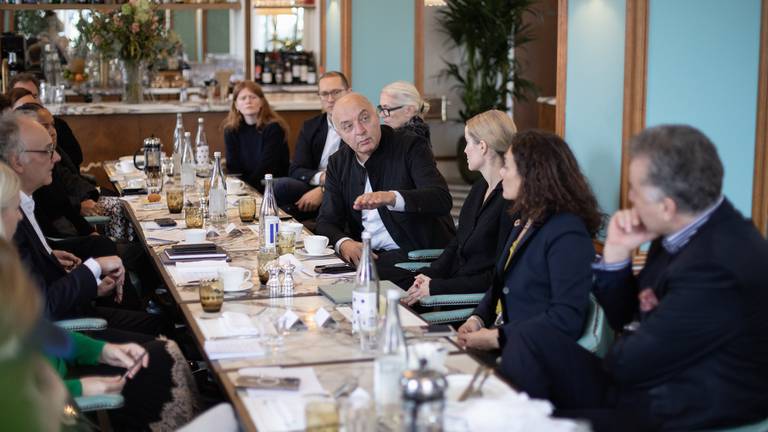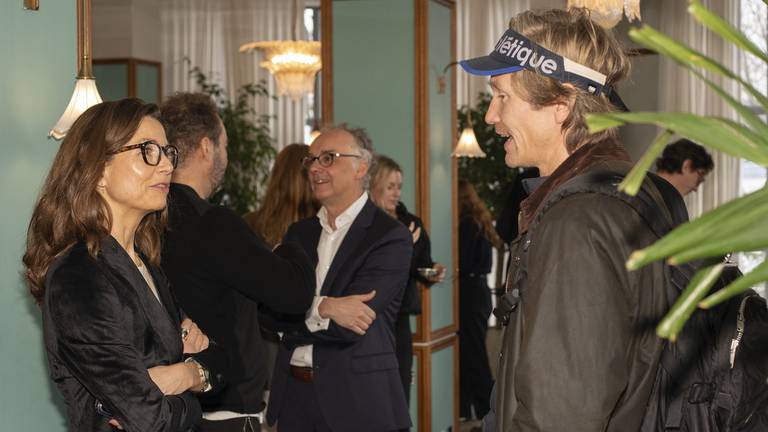
Governments and legislators appear to be waking up to the fact that companies are not reforming themselves at a pace and scale that could meaningfully combat climate change. In both the United States and the European Union, new regulatory proposals emerged this year intended to drive greater sustainability in the textile and fashion industries.
This kind of systemic change will require a collective and coordinated push from suppliers, designers, brands and retailers across fashion’s value chain. Circular business models, including resale and rental, are on track to become a $700 billion market representing 23 percent of the fashion industry by 2030. But it is not happening fast enough, nor at a great enough scale.
Copenhagen Fashion Week (CPHFW) is one of the organisations reimagining the systems our industry is built on. Since taking the helm at CPHFW in 2018, Cecilie Thorsmark has succeeded in amplifying the fashion week’s impact while increasing its ambitions.
“This particular edition of Fashion Week marks a milestone for our event and for our organisation as we have finally, after three years, implemented sustainability requirements that have gone into effect,” explained Thorsmark in her welcome. “It’s specifically 18 minimum standards that cover the entire value chain, meaning all brands that are with us at Copenhagen Fashion Week must be able to live up to the standards and submit documentation to back it in order to be admitted to our fashion week.”
Hosted by BoF senior director Robin Mellery-Pratt, the event assembled leaders from across the value chain, including: Pascal Morand, executive president of Fédération Française de la Haute Couture et de la Mode (FHCM); Julie Gilhart of Tomorrow Ltd.; Nicolaj Reffstrup, co-founder of Ganni; Christiane Arp, chair of the Fashion Council Germany; Josephine Philips, founder and CEO of Sojo; sustainability journalist Clare Press; Members of the European Parliament, Pernille Weiss and Dr Christian Ehler, and executives from Renewcell and Lenzing.
Conducted under the Chatham House rule, below we share anonymised insights with the BoF community and wider industry.
Regulation and Consultation
Attendees stressed the need for the industry and legislators to work together to find realistic compromise that will effectively reduce the impact of fashion on the planet. The fashion industry cannot hope to continue its existing operations more sustainably. The reduction in emissions and waste will not be sufficient even if best practices are adopted industry-wide.
“Today, we are looking at 16 pieces of legislation in Brussels. Concrete legislation that will change the way we operate, produce things, handle our waste et cetera. I always say that the textile and fashion industries are moving from an unregulated sector to [becoming] a very regulated industry. Some companies do not necessarily like that. That makes them nervous because, what will it mean? What will be the cost? What will be the impact on my competitiveness? There’s many, many questions,” said one attendee.
“We need to be very careful that the quality of that legislation is adequate, making sure it’s clear [and] understandable. What’s the impact on competitiveness? If it’s going to be implemented, can it be monitored? As an industry, which is not an easy thing to say, we welcome that legislative move.
“Overall, we say it’s good to have that, to create clarity in industry, to create transparency. If we bring good arguments, as an industry, the legislature will listen to us. We need to bring good arguments, based on science, based on facts, to try to move away from ideology, emotion.”
The textile and fashion industries are moving from an unregulated sector to [becoming] a very regulated industry. Some companies do not necessarily like that. That makes them nervous because, what will it mean? What will be the cost?
Another attendee highlighted the need for a cultural shift in driving further collaboration as well as the critical role of increasing value in B2B interactions.
“[By] having an eye-to-eye level conversation between stakeholders — industry, politicians and other stakeholders from research, social aspects, et cetera — I strongly underline the need for us to try to develop such culture within the ecosystem. We need to discuss with each other how can we redesign [the fashion industry]. Really being truly innovative and remembering the different kinds of stakeholders who are in this room here.
“Working more into the details, I would recommend [focusing] on the digital passport actually. What can create true value for the environment and the climate is the B2B communication on data. So how can digital passports be designed in a way where it is giving the most value to the next generation by focusing on B2B? Then, from the design of the passport, we can then take out the relevant information that consumers can actually use, […] also giving consumers the possibility to give back feedback to the same database, so we don’t create a lot of labels, a lot of databases, that don’t communicate with each other and therefore don’t bring any value to the concept.”
Tax incentives were raised as a necessary stimulus to adoption.
“It seems so clear to me that with any legislation there has to come incentives. There has to be tax incentives because the cost of running a business right now is so high on all levels, and if you are a company that has shareholders, you are beholden to them. […] That’s not going to change.
“The other [important] thing is the marketing part. I was talking to [a CEO of a brand] and they told me 80 percent of what they think about is marketing. This I thought was really eye-opening, to have a marketing campaign and design into it […]. If you are thinking that 80 percent of it is marketing, then you have to be talking about sustainability and you have to have the courage to do it.”
Who Should Bear the Cost?
“I think the question we should ask is: what is the real cost? For some raw material producers, the cost is negligible — we are talking about a cent range. But the price for us is not a cost for the fashion industry and what drives the cost. I think […] the root cause of all the problems we have is the sheer product complexity on a retail-level because it’s a completely different scale than any other industry. If you think of other consumer goods, you have a lot of stability here; if you talk about fashion products, you have millions of products, and totally different products.
“The first thing to tackle is […] traceability and transparency because you need to know [what] the complexity even looks like. I think, in terms of legislation, […] we can expect a lot of regulation from the EU Parliament, […] [and] I think it’s really a hard thing to do because the nature of the textile and fashion industry is individuality.”
One attendee stressed that the conflicting interests of the same individual consuming in their personal life while being concerned about consumption at a national and international level requires a more creative solution than limitations.
We propose to differentiate VAT rates between sustainable textiles and non-sustainable textiles. But then it becomes, how you do you define a sustainable business?
“The subject we are addressing is the citizen and the consumer, but it’s a permanently changing subject because it starts […] as a citizen engaged with sustainability and concerned about the end of the world, and then that person changes immediately to a consumer, being in a shop and saying, ‘Okay, now what is my judgment? Is it about attractiveness? Is it about price?’
“No regulation, or whatever we want to impose on citizens or consumers, is going to work without a creative idea behind that. [Some members of the industry that still believe] we are creators, usually wouldn’t like to care about that, but somehow, we have to. If we don’t merge that discussion, we are not going to come to a proper regulation because, [by] just to [regulating], we are in the world of cost comparisons.
“[There is] the principle of ‘the polluter pays,’ [but] how is that possible to weave into how we work with the tools? […] Maybe that can [decrease] the volumes in a fair way. […] [If] we incorporate that [principle] in a lot of other industrial ecosystems, maybe that can be addressed in the way we can collaborate continuously.”
Another attendee agreed: “We propose to differentiate VAT rates between sustainable textiles and non-sustainable textiles: 6 percent versus 21 percent. But then it becomes, how you do you define a sustainable business?”
Volume Matters
The comparatively small size of the fashion industry within the much larger apparel and textile industry prompted another attendee to refocus the narrative on the scale of textile production globally.
“Let’s take the apparel market in Europe, which is something like €300 billion. High-end, let’s say luxury, and designer brands are supposed to represent something like 10 percent of the market. The problem is, what’s happening with ultra-discounts, going online with very low prices and huge volumes. This is absolutely key. Once again, this is not to say, ‘Oh, it’s not us, it’s them’ — it’s all of us. But it’s important to inform the consumers and the citizen of the reality, the truth, and the orders of magnitude. We know that we have more than 100 billion pieces produced each year. If we look at the forecast of the production of chemical fibres, it is rising by 4 percent to 5 percent per year, and so that’s very important.

“Let’s also keep in mind that, if we look at the European employment, for instance, […] in some of the countries, […] luxury brands and designers’ brands represent a major part of European employment with [that] volume.
“If we just stand still now, volume is going to [still increase], just to [other] people in the world. […] If you look at Asia and Africa, that’s going to drive up volume by more than 50 percent within [something like] 25 years. We need to drive down volume because we are not going to be able to innovate ourselves, even in that timeframe. We need to figure out how we drive down volume as volume is related to price.”
But inefficiencies in business and production models could still play a significant role, believes one attendee.
“If we are routinely wasting up to a third of everything that’s produced, which is highly inefficient, but we still do it, regulation is the answer. We need to make it illegal to dispose of unsold stock, which I know is happening, [and] there is also a growing awareness in the consumer [about this practice],” another attendee responded.
Consumer Choice
In response to the interjection that only 3 percent of consumers choose the more sustainable option, one attendee countered: “I’m not sure it’s about sustainable choice at the till. I think it’s about people being aware of the system that has in-built waste to a ridiculous level that we are producing items ostensibly to immediately burn them.”
The need for more consistent consumer-facing labelling was also raised. “What is better: a polyester T-shirt or a cotton T-shirt? You can have that discussion for the rest of the day, but we need to get [that] clear ourselves as an industry, so that we can communicate more clearly to the consumer what the environmental impact is, what is generally sustainable, what is not,” said another participant.
What is better: a polyester T-shirt or a cotton T-shirt? […] We need to get [that] clear ourselves as an industry, so that we can communicate more clearly to the consumer what the environmental impact is.
“From an industry perspective, at a retail level today, there are [hundreds of] green labels existing, [hundreds of] eco this, green that, for the consumer. We can’t blame the consumer for being confused. What can we do together to get rid of these [hundreds of] labels? It’s naive to dream of a single label, I know it’s not going to happen, but [we could] create, at least, a bit more transparency and then we can educate the consumer.
“There are so many more reports on this in the news now than there used to be on the kind of grotesque nature of how wasteful production. People get it. […] So many people are aware of things [today] that they were not aware of a few years ago, we’re almost swinging so far towards shaming the industry, [and] are we in danger of getting stuck and being unable to talk about what we are doing around innovation and how we might make sustainable change because there’s such a culture of cynicism around our track record of destruction — of stock and of lives.”
“Consumers are getting outraged by it. I think there’s an appetite for regulating, which will force the industry to address its volume question,” another attendee continued.
“Eight-year-old kids know more about plastic pollution and textile waste than most of my friends. We are actually seeing a societal change. I think it’s about industry getting ahead of the next generation,” added another attendee.
Resale, Recycling and Repair
“Ultimately, we are seeing second-hand grow 11 times faster than fast fashion. We are seeing different circular adoption that is happening. There is no one way of saying the future of fashion is X, [like] the future of fashion is rental [or] resale. It is the combination of everything. It is saying, ‘we can go heavily on recycling and making it a fantastic thing to do,” but what that will mean is, disposability comes even more common, and then you have to buy more.
“It’s still fuelling consumption, whereas repair is completely about slowing it down. It’s about saying, ‘I’m going to have this item for 20, 30 years, and we’re enabling you to do that.’
“Ultimately, being able to get insight to customers [and] to brands, to say, […] ‘this is the most common material that is ripping in our fashion industry,’ and ‘that zip [is] what’s causing breakages, and that’s driving waste.’ That data does not exist,” shared one attendee.
“One of the definitions of a luxury product is [that] it is a product which can be repaired,” added another participant.
Fashion Weeks
One attendee shared that the average garment is worn six times, and another responded: “For me, that’s the real concern. I think, as brands, as designers, we are so intent on addressing how to design circularity, how to recycle, how to upcycle, how to innovate. What we need help with is [how] to prioritise what is more important […] and develop our language so that we can communicate to our consumers.

“We design products today to be repaired, so we add in centre seams, and higher hems because we want to be able for the product to have a long lifespan. […] We have two big fashion weeks a year, and in many different markets, we create a minimum of four collections, and each collection has three deliveries at minimum. Then, we create sub brands when we cannot fit all the SKUs into the brands.
“I think that’s the real problem. We are feeding the need for newness, and we are telling the consumer constantly that there is such a thing as aesthetic seasonality, not just the seasonality of winter from summer. We are literally feeding this need to constantly change materials, silhouettes, whatever.”
Another attendee agreed: “I would love to challenge the role of fashion weeks and move beyond the seasonality [and] commercial. What is the purpose of a fashion week? Is it just to produce new trends and sell them? That is what a fashion week was for traditionally. I think that we have a responsibility as these super impactful arenas. We have the potential to, first of all, work closely with the brands that are part of our fashion week.
“Be the platform that also constantly pushes for more change, for more consideration of new business models, for example. […] I think that fashion weeks can lift [their] positioning to more responsible heights and engage a lot more with the [represented] brands.”
Fashion weeks don’t need to be focussed on seasonal overproduction. They could be powerful cultural spotlights that supported young talent without driving waste and over-consumption.
The attendee also referred to fashion weeks as a “billboard of the way things should be,” stating: “Buyers can’t even go to half of the shows now, because they’re geared to the press. […] We have to [change that].
“If you talk to young designers, they would say, ‘I want to be at the right place with the right people, and I want to see and meet my community, because they only see them via my Instagram life.’ I think there is a need for a show space to just make them visible as well. I don’t like to call it fashion week, but to create a stage [for] visibility. The big [brands] can do their shows wherever, worldwide, and have millions of views at whatever time they want, because they have the power.
“Fashion weeks don’t need to be focussed on seasonal overproduction. They could be powerful cultural spotlights that supported young talent without driving waste and over-consumption.”
Innovation and Imagination
For one attendee, they expressed envisaging the end of cotton-based and oil-based polymer textiles, “even with recycling. We are much more interested in innovation, because we do believe that the long-term dynamics are setting an end to the recycling discussion, based on certain fibres. You can recycle one third, then you come to the limit set by the physics.
“I think that the discussion has to be broader, and we want to merge that discussion between the fashion cards, the production cards, and so and so, because we believe that, in 2040, this industry is not going to look like it [does] now, even in terms of products.
“The Obama administration [spent] $250 million on a project between cotton and the Silicon Valley to merge textiles with digital — that is going to come. Future textiles will have a health aspect [and] a digital aspect.
“If you’re honest, if you get a little bit away from this logic of the present textile industry, the goods you sell are a post-industrial product, which is somehow defining the individuality of consumers, substituting social context with consumption. That is how we think. That’s the challenge of the 21st century. We would like you to be a little bit more inventive.”
This is a sponsored feature paid for by Copenhagen Fashion Week as part of a BoF partnership.



